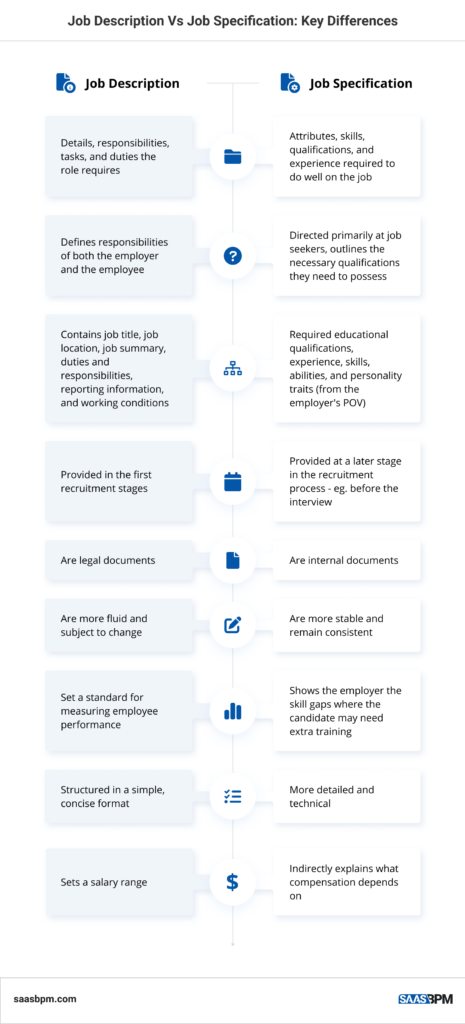The job description vs job specification debate can be confusing for many. In fact, a good number of career changers do not make a difference between the two terms.
But HR professionals have diversified them for a reason. Although both refer to the requirements of a role, each serves a unique function in the process of job creation, recruitment, and performance management.
Job descriptions and job specifications are critical tools in the arsenal of human resources. They assist not only in structuring and defining roles within an organisation but also in aligning these roles with the appropriate talent. They act as pivotal communication tools between an organisation and its current or prospective employees, aiding in setting expectations, measuring performance, and managing career progression.
For job seekers, understanding the distinction between these terms can offer valuable insight into what employers seek. It can guide them in personalising their applications, preparing for interviews, and even identifying areas for personal development and upskilling.
Let’s delve into the subtleties of these two terms by examining the ten key job description vs job specification differences. Whether you’re an HR professional aiming to refine your recruitment process, a manager seeking to better understand your team’s roles, or a job seeker attempting to decode job advertisements, this comprehensive breakdown will illuminate these pivotal concepts.
Job Description Vs. Job Specification

Purpose
The first difference between a job description and a job specification resides in their respective purposes. A job description is a detailed account of the responsibilities, tasks, and duties that an employee is expected to fulfil in a particular role. It provides a comprehensive outline of what the job entails, thereby proving essential in defining expectations for both the employer and the employee.
Conversely, a job specification centres on the attributes, skills, qualifications, and experience required to perform the job successfully. It assists employers in identifying what to seek in potential candidates, and offers job seekers an idea of the qualifications they need to possess.
Composition
The components of a job description and job specification also differ. Job descriptions typically incorporate information such as job title, job location, job summary, duties and responsibilities, reporting information, and working conditions. They provide a roadmap for the daily tasks the job holder will undertake.
Job specifications, conversely, contain details about the required educational qualifications, experience, skills, abilities, and personality traits. They depict the ‘ideal candidate’ from the employer’s perspective.
Usage in Recruitment
Both these terms play an instrumental role in recruitment, but at different stages. Job descriptions are typically used early in the recruitment process. They assist in creating job advertisements and inform potential applicants about the expectations of the role.
Job specifications are employed later in the recruitment process. They guide the selection and interview process by providing a checklist of the skills, qualifications, and attributes that ideal candidates should possess.
Legal Implications
Job descriptions can function as legal documents, particularly in disputes over employment contracts, roles, and responsibilities, and even in discrimination cases. A well-defined job description can safeguard both employers and employees by setting clear expectations and obligations.
Job specifications, however, do not usually have such legal implications. While they are essential for defining the necessary traits and qualifications of the candidate, they are typically viewed as internal documents, facilitating the recruitment and selection process.
Flexibility and Change
Job descriptions and job specifications differ in their flexibility. Job descriptions are typically more fluid, with duties and responsibilities evolving over time as the needs of the organisation change. On the other hand, job specifications tend to be more stable, as the skills, qualifications, and attributes required for a role generally remain consistent.
Employee Performance and Evaluation

Both documents have implications for employee performance and evaluation, but function differently. Job descriptions are used as a standard or benchmark for measuring employee performance. They form the basis of performance appraisals, determining if an employee is satisfactorily fulfilling their job duties.
Conversely, job specifications can assist in identifying areas for employee development. By comparing an employee’s current skill set with the skills specified for the role, managers can discern areas for further training or development.
Orientation and Training
Job descriptions play a crucial role in a new employee’s orientation and training process. They lay the groundwork for what a new hire will need to do and how their role fits within the larger organisational structure.
Job specifications, on the other hand, assist in identifying the necessary training or education that a new employee may require to perform their role effectively. They can design specific training programmes tailored to the role’s requirements.
Impact on Job Satisfaction and Motivation
Job descriptions have a direct impact on job satisfaction and motivation. A well-crafted job description clarifies the expectations of the role, ensuring employees have a clear understanding of their duties, thus reducing ambiguity and increasing job satisfaction.
Job specifications might have less of an immediate impact on job satisfaction and employee motivation, but they play a vital role in ensuring that the right person gets the job in the first place. When employees possess the skills and qualifications necessary for their position, they are more likely to succeed and be happy with their job.
Structure and Format
Job descriptions usually have a simple, concise format, outlining the duties and responsibilities of a role. They provide a holistic view of the position.
Job specifications, in contrast, might be more detailed and technical, focusing on specific skills, qualifications, and traits. They may also include details on the level of competency required for each skill, providing a granular view of the job requirements.
Relationship with Compensation and Benefits
A job description often plays a vital role in determining compensation and benefits for a position. It outlines the scope of the job and the level of responsibility, which are essential factors in setting an appropriate salary range and benefits package.
Job specifications, on the other hand, contribute to determining compensation indirectly. A role requiring highly specialised skills or a high level of experience and education might command higher compensation, and these elements are typically included in a job specification.
Conclusion
In conclusion, when comparing job description vs job specification, we see that both are important in understanding a job role, but serve different purposes. A job description provides a detailed account of the job’s duties and responsibilities, while a job specification outlines the qualifications and skills required for the role. Understanding these differences will aid both job seekers and employers navigate the recruitment process more effectively.

Author bio: Daniel Aldridge is co-founder of Check-a-Salary which was founded to help businesses, job seekers and employees calculate salaries for almost any job across the UK.

